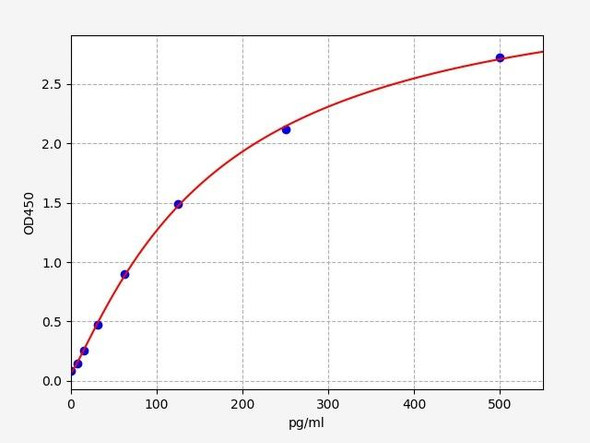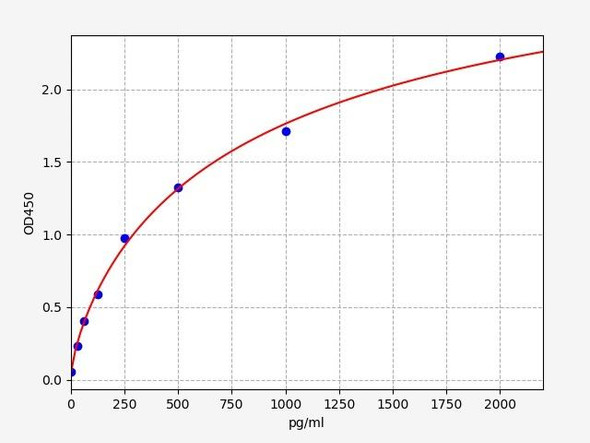Human Immunology ELISA Kits 8
Human Hepatocyte nuclear factor 1-alpha (HNF1A) ELISA Kit
- SKU:
- HUEB1671
- Product Type:
- ELISA Kit
- Size:
- 96 Assays
- Uniprot:
- P20823
- ELISA Type:
- Sandwich
- Synonyms:
- HNF1 alpha
- Reactivity:
- Human
Description
| Product Name: | Human Hepatocyte nuclear factor 1-alpha (HNF1A) ELISA Kit |
| Product Code: | HUEB1671 |
| Alias: | Hepatocyte nuclear factor 1-alpha, HNF-1-alpha, HNF-1A, Liver-specific transcription factor LF-B1, LFB1, Transcription factor 1, TCF-1, HNF1A, TCF1 |
| Uniprot: | P20823 |
| Reactivity: | Human |
| Range: | Please contact us for more information |
| Detection Method: | Sandwich |
| Size: | 96 Assay |
| Storage: | Please see kit components below for exact storage details |
| Note: | For research use only |
| UniProt Protein Function: | HNF1A: Transcriptional activator that regulates the tissue specific expression of multiple genes, especially in pancreatic islet cells and in liver. Required for the expression of several liver specific genes. Binds to the inverted palindrome 5'- GTTAATNATTAAC-3'. Defects in HNF1A are a cause of hepatic adenomas familial (HEPAF). Hepatic adenomas are rare benign liver tumors of presumable epithelial origin that develop in an otherwise normal liver. Hepatic adenomas may be single or multiple. They consist of sheets of well-differentiated hepatocytes that contain fat and glycogen and can produce bile. Bile ducts or portal areas are absent. Kupffer cells, if present, are reduced in number and are non-functional. Conditions associated with adenomas are insulin-dependent diabetes mellitus and glycogen storage diseases (types 1 and 3). Bi-allelic inactivation of HNF1A, whether sporadic or associated with MODY3, may be an early step in the developmant of some hepatocellular carcinomas. Defects in HNF1A are the cause of maturity-onset diabetes of the young type 3 (MODY3); also symbolized MODY-3. MODY is a form of diabetes that is characterized by an autosomal dominant mode of inheritance, onset in childhood or early adulthood (usually before 25 years of age), a primary defect in insulin secretion and frequent insulin-independence at the beginning of the disease. Defects in HNF1A are the cause of susceptibility to diabetes mellitus insulin-dependent type 20 (IDDM20). IDDM20 is a multifactorial disorder of glucose homeostasis that is characterized by susceptibility to ketoacidosis in the absence of insulin therapy. Clinical fetaures are polydipsia, polyphagia and polyuria which result from hyperglycemia-induced osmotic diuresis and secondary thirst. These features can result in long-term complications that affect the eyes, kidneys, nerves, and blood vessels. Belongs to the HNF1 homeobox family. 3 isoforms of the human protein are produced by alternative splicing. |
| UniProt Protein Details: | Protein type:DNA-binding; Transcription factor Chromosomal Location of Human Ortholog: 12q24.2 Cellular Component: nucleoplasm; protein complex; cytoplasm; nucleus Molecular Function:protein dimerization activity; protein binding; protein homodimerization activity; DNA binding; protein heterodimerization activity; transcription factor activity Biological Process: regulation of transcription from RNA polymerase II promoter; transcription, DNA-dependent; insulin secretion; glucose import; positive regulation of transcription, DNA-dependent; positive regulation of transcription from RNA polymerase II promoter; glucose homeostasis Disease: Diabetes Mellitus, Insulin-dependent, 20; Diabetes Mellitus, Insulin-dependent; Hepatic Adenomas, Familial; Maturity-onset Diabetes Of The Young, Type 3; Renal Cell Carcinoma, Nonpapillary; Diabetes Mellitus, Noninsulin-dependent |
| NCBI Summary: | The protein encoded by this gene is a transcription factor required for the expression of several liver-specific genes. The encoded protein functions as a homodimer and binds to the inverted palindrome 5'-GTTAATNATTAAC-3'. Defects in this gene are a cause of maturity onset diabetes of the young type 3 (MODY3) and also can result in the appearance of hepatic adenomas. Alternative splicing results in multiple transcript variants encoding different isoforms. [provided by RefSeq, Apr 2015] |
| UniProt Code: | P20823 |
| NCBI GenInfo Identifier: | 51338763 |
| NCBI Gene ID: | 6927 |
| NCBI Accession: | P20823.2 |
| UniProt Secondary Accession: | P20823,Q2M3H2, Q99861, A5Z2R8, E0YMJ5, E0YMK0, E0YMK1 E2I9R4, E2I9R5, F5H5U3, |
| UniProt Related Accession: | P20823 |
| Molecular Weight: | 12,491 Da |
| NCBI Full Name: | Hepatocyte nuclear factor 1-alpha |
| NCBI Synonym Full Names: | HNF1 homeobox A |
| NCBI Official Symbol: | HNF1A |
| NCBI Official Synonym Symbols: | HNF1; LFB1; TCF1; MODY3; TCF-1; HNF-1A; IDDM20 |
| NCBI Protein Information: | hepatocyte nuclear factor 1-alpha |
| UniProt Protein Name: | Hepatocyte nuclear factor 1-alpha |
| UniProt Synonym Protein Names: | Liver-specific transcription factor LF-B1; LFB1; Transcription factor 1; TCF-1 |
| Protein Family: | Hepatocyte nuclear factor |
| UniProt Gene Name: | HNF1A |
| UniProt Entry Name: | HNF1A_HUMAN |
| Component | Quantity (96 Assays) | Storage |
| ELISA Microplate (Dismountable) | 8×12 strips | -20°C |
| Lyophilized Standard | 2 | -20°C |
| Sample Diluent | 20ml | -20°C |
| Assay Diluent A | 10mL | -20°C |
| Assay Diluent B | 10mL | -20°C |
| Detection Reagent A | 120µL | -20°C |
| Detection Reagent B | 120µL | -20°C |
| Wash Buffer | 30mL | 4°C |
| Substrate | 10mL | 4°C |
| Stop Solution | 10mL | 4°C |
| Plate Sealer | 5 | - |
Other materials and equipment required:
- Microplate reader with 450 nm wavelength filter
- Multichannel Pipette, Pipette, microcentrifuge tubes and disposable pipette tips
- Incubator
- Deionized or distilled water
- Absorbent paper
- Buffer resevoir
*Note: The below protocol is a sample protocol. Protocols are specific to each batch/lot. For the correct instructions please follow the protocol included in your kit.
Allow all reagents to reach room temperature (Please do not dissolve the reagents at 37°C directly). All the reagents should be mixed thoroughly by gently swirling before pipetting. Avoid foaming. Keep appropriate numbers of strips for 1 experiment and remove extra strips from microtiter plate. Removed strips should be resealed and stored at -20°C until the kits expiry date. Prepare all reagents, working standards and samples as directed in the previous sections. Please predict the concentration before assaying. If values for these are not within the range of the standard curve, users must determine the optimal sample dilutions for their experiments. We recommend running all samples in duplicate.
| Step | |
| 1. | Add Sample: Add 100µL of Standard, Blank, or Sample per well. The blank well is added with Sample diluent. Solutions are added to the bottom of micro ELISA plate well, avoid inside wall touching and foaming as possible. Mix it gently. Cover the plate with sealer we provided. Incubate for 120 minutes at 37°C. |
| 2. | Remove the liquid from each well, don't wash. Add 100µL of Detection Reagent A working solution to each well. Cover with the Plate sealer. Gently tap the plate to ensure thorough mixing. Incubate for 1 hour at 37°C. Note: if Detection Reagent A appears cloudy warm to room temperature until solution is uniform. |
| 3. | Aspirate each well and wash, repeating the process three times. Wash by filling each well with Wash Buffer (approximately 400µL) (a squirt bottle, multi-channel pipette,manifold dispenser or automated washer are needed). Complete removal of liquid at each step is essential. After the last wash, completely remove remaining Wash Buffer by aspirating or decanting. Invert the plate and pat it against thick clean absorbent paper. |
| 4. | Add 100µL of Detection Reagent B working solution to each well. Cover with the Plate sealer. Incubate for 60 minutes at 37°C. |
| 5. | Repeat the wash process for five times as conducted in step 3. |
| 6. | Add 90µL of Substrate Solution to each well. Cover with a new Plate sealer and incubate for 10-20 minutes at 37°C. Protect the plate from light. The reaction time can be shortened or extended according to the actual color change, but this should not exceed more than 30 minutes. When apparent gradient appears in standard wells, user should terminatethe reaction. |
| 7. | Add 50µL of Stop Solution to each well. If color change does not appear uniform, gently tap the plate to ensure thorough mixing. |
| 8. | Determine the optical density (OD value) of each well at once, using a micro-plate reader set to 450 nm. User should open the micro-plate reader in advance, preheat the instrument, and set the testing parameters. |
| 9. | After experiment, store all reagents according to the specified storage temperature respectively until their expiry. |
When carrying out an ELISA assay it is important to prepare your samples in order to achieve the best possible results. Below we have a list of procedures for the preparation of samples for different sample types.
| Sample Type | Protocol |
| Serum | If using serum separator tubes, allow samples to clot for 30 minutes at room temperature. Centrifuge for 10 minutes at 1,000x g. Collect the serum fraction and assay promptly or aliquot and store the samples at -80°C. Avoid multiple freeze-thaw cycles. If serum separator tubes are not being used, allow samples to clot overnight at 2-8°C. Centrifuge for 10 minutes at 1,000x g. Remove serum and assay promptly or aliquot and store the samples at -80°C. Avoid multiple freeze-thaw cycles. |
| Plasma | Collect plasma using EDTA or heparin as an anticoagulant. Centrifuge samples at 4°C for 15 mins at 1000 × g within 30 mins of collection. Collect the plasma fraction and assay promptly or aliquot and store the samples at -80°C. Avoid multiple freeze-thaw cycles. Note: Over haemolysed samples are not suitable for use with this kit. |
| Urine & Cerebrospinal Fluid | Collect the urine (mid-stream) in a sterile container, centrifuge for 20 mins at 2000-3000 rpm. Remove supernatant and assay immediately. If any precipitation is detected, repeat the centrifugation step. A similar protocol can be used for cerebrospinal fluid. |
| Cell culture supernatant | Collect the cell culture media by pipette, followed by centrifugation at 4°C for 20 mins at 1500 rpm. Collect the clear supernatant and assay immediately. |
| Cell lysates | Solubilize cells in lysis buffer and allow to sit on ice for 30 minutes. Centrifuge tubes at 14,000 x g for 5 minutes to remove insoluble material. Aliquot the supernatant into a new tube and discard the remaining whole cell extract. Quantify total protein concentration using a total protein assay. Assay immediately or aliquot and store at ≤ -20 °C. |
| Tissue homogenates | The preparation of tissue homogenates will vary depending upon tissue type. Rinse tissue with 1X PBS to remove excess blood & homogenize in 20ml of 1X PBS (including protease inhibitors) and store overnight at ≤ -20°C. Two freeze-thaw cycles are required to break the cell membranes. To further disrupt the cell membranes you can sonicate the samples. Centrifuge homogenates for 5 mins at 5000xg. Remove the supernatant and assay immediately or aliquot and store at -20°C or -80°C. |
| Tissue lysates | Rinse tissue with PBS, cut into 1-2 mm pieces, and homogenize with a tissue homogenizer in PBS. Add an equal volume of RIPA buffer containing protease inhibitors and lyse tissues at room temperature for 30 minutes with gentle agitation. Centrifuge to remove debris. Quantify total protein concentration using a total protein assay. Assay immediately or aliquot and store at ≤ -20 °C. |
| Breast Milk | Collect milk samples and centrifuge at 10,000 x g for 60 min at 4°C. Aliquot the supernatant and assay. For long term use, store samples at -80°C. Minimize freeze/thaw cycles. |






